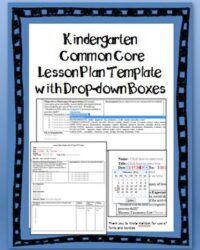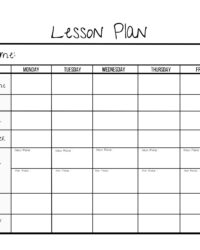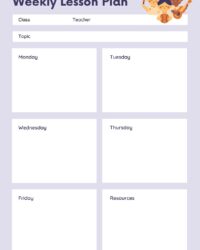Every teacher knows the drill: the constant juggle of lesson planning, curriculum alignment, and making sure every minute counts in the classroom. It can feel like an endless cycle of creating, adjusting, and refining, all while ensuring that what you teach genuinely resonates with your students and meets rigorous educational benchmarks. Among these benchmarks, the Common Core State Standards stand as a foundational guide for many educators, shaping the learning journey from kindergarten through high school.
Navigating these standards while also crafting engaging, effective lessons for an entire week can be quite the challenge. That’s where a well-designed, comprehensive weekly lesson plan template for Common Core Standards becomes an invaluable tool. It’s not just about filling in boxes; it’s about creating a roadmap that streamlines your preparation, clarifies your objectives, and ultimately empowers you to deliver exceptional instruction with confidence and ease.
Why a Dedicated Template Makes All the Difference
Think about the hours you spend each week, piecing together your lessons. Without a consistent framework, it’s easy for things to become disjointed, leading to missed opportunities for deeper learning or, worse, overlooked standards. A dedicated template serves as your organizational anchor, bringing uniformity to your planning process. It ensures that regardless of the subject or grade level, you’re always thinking through the essential elements that make a lesson successful.
Beyond just organization, a robust template significantly boosts efficiency. Instead of reinventing the wheel every time, you’re filling in a pre-structured document that prompts you to consider all necessary components. This not only saves precious time but also reduces the mental load of planning, allowing you to focus more on the art of teaching and less on the mechanics of paperwork. Imagine the relief of knowing you have a clear, step-by-step guide ready to go, week after week.
Crucially, for educators working with Common Core Standards, a tailored template is your best friend for ensuring alignment. The Common Core is detailed, with specific standards for ELA and Math that require careful consideration. A template designed with these standards in mind will prompt you to explicitly link your activities, assessments, and learning objectives back to the relevant Common Core expectations. This helps guarantee that your instruction is always purposeful and directly contributes to students achieving those critical benchmarks.
Moreover, consistent use of a template enhances clarity and communication, not just for you, but for your students, colleagues, and even substitute teachers. When plans are structured predictably, it’s easier to see the progression of learning, identify areas for reteaching, and ensure that everyone involved understands the goals for the week. This transparency fosters a more cohesive and supportive learning environment for all.
Key Components of an Effective Common Core Lesson Plan
What exactly should a stellar weekly lesson plan template for Common Core Standards include? It’s more than just a schedule; it’s a comprehensive blueprint for learning. Here are the crucial sections that make a template truly effective:
Standards Alignment
This is where you explicitly state the specific Common Core State Standards that your lessons for the week will address. Be precise, noting the grade level, subject, and the exact code (e.g., CCSS.ELA-LITERACY.RL.5.1).
Learning Objectives
Clearly define what students will know and be able to do by the end of the week or specific lessons, using measurable verbs. These objectives should directly stem from your chosen Common Core standards.
Materials and Resources
List all necessary textbooks, worksheets, technology, manipulatives, or other resources required for each lesson. Being prepared saves valuable class time.
Instructional Activities
Detail the sequence of learning activities for each day or lesson, including mini-lessons, group work, independent practice, and transitions. Describe your teaching strategies and student engagement methods.
Assessment Strategies
Explain how you will measure student understanding throughout the week. This can include formative assessments (e.g., exit tickets, quick checks, observations) and summative assessments (e.g., quizzes, projects, essays).
Differentiation
Outline how you will adapt instruction to meet the diverse needs of your learners. This might involve strategies for scaffolding, enrichment, support for English language learners, or accommodations for students with IEPs.
Reflection and Notes
Include space for you to jot down notes about what worked well, what challenges arose, and what adjustments you might make for future instruction. This critical reflective practice fuels continuous improvement.
Implementing Your Weekly Lesson Plan Template for Common Core Standards
Once you have a fantastic weekly lesson plan template for Common Core Standards, the next step is to put it into action effectively. It’s not just about filling it out once and forgetting it; it’s about making it a living document that guides your teaching. Start by reviewing the Common Core standards for your grade level and subject at the beginning of each unit, then break them down into manageable weekly chunks. This forward-thinking approach ensures a cohesive and logical progression of learning throughout the school year.
Remember that a template is a guide, not a rigid prison. While it provides structure, it should also offer the flexibility needed to adapt to real-time classroom dynamics. If a lesson isn’t landing or students need more time on a particular concept, your template should allow for easy adjustments. Think of it as your trusted co-pilot, helping you navigate the journey but giving you the freedom to steer when necessary. This adaptability is key to responsive teaching and meeting the immediate needs of your students.
Don’t hesitate to share your well-crafted plans with colleagues. Collaborative planning using a shared template can lead to deeper insights, foster consistency across grade levels or subjects, and lighten the load for everyone. You might discover new activities, assessment ideas, or differentiation strategies that perfectly align with your goals. The collective wisdom of a teaching team can elevate the quality of instruction for all students.
Embracing a structured approach to weekly lesson planning doesn’t just simplify your professional life; it also profoundly impacts your students’ learning experience. By having a clear, thoughtfully constructed plan, you can enter the classroom feeling prepared, focused, and ready to inspire. This confidence translates directly into more engaging lessons, better management of time, and ultimately, a more impactful educational journey for every child.
The dedication you pour into meticulously planning each week, guided by a robust template, truly pays dividends. It ensures that every instructional minute is purposeful, every standard is addressed, and every student has the opportunity to thrive. Consider how this systematic approach can transform your classroom into a highly organized, dynamic learning environment where both you and your students can achieve remarkable success.


